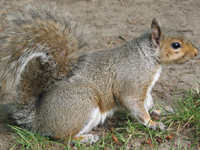

 |

|
 Gray Squirrel |
Gray Squirrel(Mammal) |
 Gray Squirrel Baby |
Gray Squirrel HabitsAlthough the gray squirrel is found in parks and yards, woodlands are its preferred habitat. It builds its den in tree branches, inside a hollow trunk, or in an empty birds nest. It usually lines the nest with moss, thistledown, dried grass, and feathers and builds a cover. A gray squirrel will build several nests or dens and use them all. When a female has young, the nest is theirs alone, but winter nests are often shared to generate warmth.
The gray squirrel is one of the easiest animals to observe. It is found in parks and woods amoung both coniferous and deciduous trees, which provide a plentiful source of food. A squirrel's den can be found in a hollow tree or built between sturdy branches. Winter and breeding nests are usually larger then the summer nests and they are built of studier material. If you find an abandoned baby squirrel, it is best to leave it alone, since it must be fed every two to four hours for several weeks. Gray squirrels do not make good pets and may carry rabies. |
Gray Squirrel CommunicationCommunication among gray squirrels involves both vocalizations and posturing. The species has a varied repertoire of vocalizations, including a squeak similar to that of a mouse, a low-pitched noise, a chatter, and a raspy "mehr mehr mehr". Other methods of communication include tail-flicking. Communications are mainly used in mating season and to ward off predators.
The use of vocal and visual communication has been shown to vary by location, based on elements such as noise pollution and the amount of open space. For instance, populations living in large cities generally rely more on the visual signals, due to the generally louder environment with more areas without much visual restriction. However, in heavily wooded areas, vocal signals are used more often due to the presence of less noise and a dense canopy restricting visual range. |
Gray Squirrel BreedingFemale squirrels can mate only twice a year, but males can mate at any time. Often, severalmales will attempt to mate with the same female. They try to attract her attention by slapping the bark of trees with their paws and chattering loudly. After the mating the males play no part in the rearing of the young.
Birth occurs six weeks after mating. The naked, blind young are fed every two to four hours for several weeks. At seven weeks, they follow their mother out on the tree branches and before long have learned to climb. The young squirrels gradually begin to eat solid food and are weaned at 10 weeks of age. A month later, they leave the den. If there are not too many squirrels in the area, the young will build the dens nearby. Otherwise, they will be chased away to less crowded feeding area. |
Gray Squirrel Food & FeedingThe Gray Squirrel every day even in the winter. It does not hibornate and is unable to conserve enough energy to survive for long periods without food. It is most active at dawn and dusk, when it searchesfor whatever fruit, shoots, and seeds are in season. Small thumbs on it's front paws allow it to hold securely as it feeds. The squirrel's diet varies according to season. It eats manly tree bark and fungi in the winter and buds in the summer. In September it eats nuts and accorns. A hungry gray squirrel will also raid a bird's nest for eggs, steal food from bird feeders and dig up plants. The squirrel buries extra food just below the soils surface, which it later locates by smell. |
Gray Squirrel Key Facts |
| Size |
| Height: Body length: 9-12 in. Tail length: 7-10 in. |
| Weight: 12-28 oz |
| Breeding |
| Sexual maturity: 11 months |
| Mating: Females may have 2 litters a year, 1 in March or April and the other in June or July |
| Gestation: About 44 days |
| Number of young: Usually 3, but up to 9 |
| Lifestyle |
| Habit: Tree-dwelling, but spends much of it's time on the ground |
| Diet: Mainly tree seeds |
| Lifespan: 3-4 years |
DID YOU KNOW?
|
CAN'T FIND WHAT YOU'RE LOOKING FOR? CLICK HERE!!!